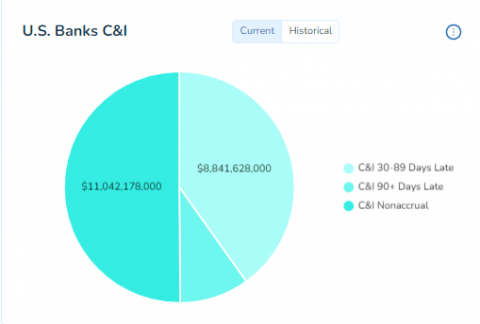Commercial non-performing mortgage loans seemed to have continued to decline in volume since peaking in Q4 2020.
![U.S. Commercial Loans and REO Chart [Q4 2021]](https://www.distressedpro.com/wp-content/uploads/2022/02/US-Commercial-Historical-Q4-2021-480x326.png)
The one big difference in this sector from other mortgages is there being more commercial REOs than residential or MF. At the end of Q4 2021, 822 banks reported that they held commercial REOs – almost 100 fewer than in Q3.
New defaults and delinquent loans still appear to be mostly comprised of those in the non-accrual stage.
Overall commercial real estate sales have been surprisingly strong considering the pandemic, though, with office and retail much less popular. Investors have been focusing their capital on industrial real estate and apartment buildings instead.
Moving into 2022, non-performing loans held by banks included:
- $1.3B in 30-89 day late owner occupied loans
- $6.8B in nonaccrual stage non-owner occupied CRE loans
- $1.8B in 30-89 day late non-owner occupied loans
- $4B in nonaccrual stage owner occupied CRE loans
Find out which banks have the most non-performing commercial loans inside BankProspector.
Construction Debt
![Construction Chart Current [Q4 2021]](https://www.distressedpro.com/wp-content/uploads/2022/02/US-Banks-Construction-Current-Q4-2021-480x328.png)
Overall distressed construction loan volume continued to fall through Q4 2021, now still just a fraction of the distress we saw in the aftermath of the Great Recession.
There was just shy of $600M in construction REO being held by banks at the end of the year, just under the level of residential REO.
The largest percentage of this debt is made up of loans in the non-accrual stage, at $1.6B, with around $1.2B in delinquent loans behind that.
Extreme inflation, supply chain issues, labor shortages, and questions over the future of work and lifestyles continue to be factors at play here.
Other Debt
Agricultural
Farmland loan performance seems to have mimicked other mortgage trends. This sector has been steadily declining over the past year.
The largest part of this pool is the $1.1B in non-accrual debt, followed by $318M in newly late loans, and around $64M in REO.
With land still selling fast, no huge crisis is anticipated in this sector yet.
Business C&I Debt

Non-performing business debt reversed trends last quarter and rose again. This may signal stimulus dollars have run out, while businesses have continued to languish under COVID restrictions, and perhaps their own price hikes.
Investors looking for a big space to take on will find there were still over $11B in nonaccrual stage loans in this category as of the beginning of 2022.
There were almost $11B in delinquent C&I loans behind that as well.
Consumer Debt: Auto Loans & Credit Cards
Non-performing auto loans spiked again in Q4, following a year-long trend in rising distress. Though that is not necessarily uncommon by seasonal auto credit trends.
76% of this data is made up of newly late 30 to 89 day past due auto loans, a pool that has increased at the pace of around $1B per quarter over the past two quarters.
Credit card performance has also continued to deteriorate over the past year. Over $14B in debt sits in the 30 to over 90 days late category as of Q4 – around a 40% increase over the previous period.
It may be a sign that those who have been living on credit cards to ride out the impacts of the pandemic are finally out of options. If that is true, these delinquencies and defaults could roll over into other forms of debt in the months ahead.
Looking Ahead
The overall commercial mortgage sector seems to be in good health. This is especially true for construction debt.
Healthy CRE sales volumes have definitely helped stave off more defaults. However, auto, credit card, and business debt trends suggest the final quarter of 2021 was not a flush one for many consumers and companies. We’ll have to wait to see if this distress flows over into other categories.
One of the largest areas of opportunity for debt investors appears to be in the business debt sector. It is one of the largest in volume, one which may have less competition than residential real estate or multifamily.
Log in now to see which banks are holding the most distressed notes.

